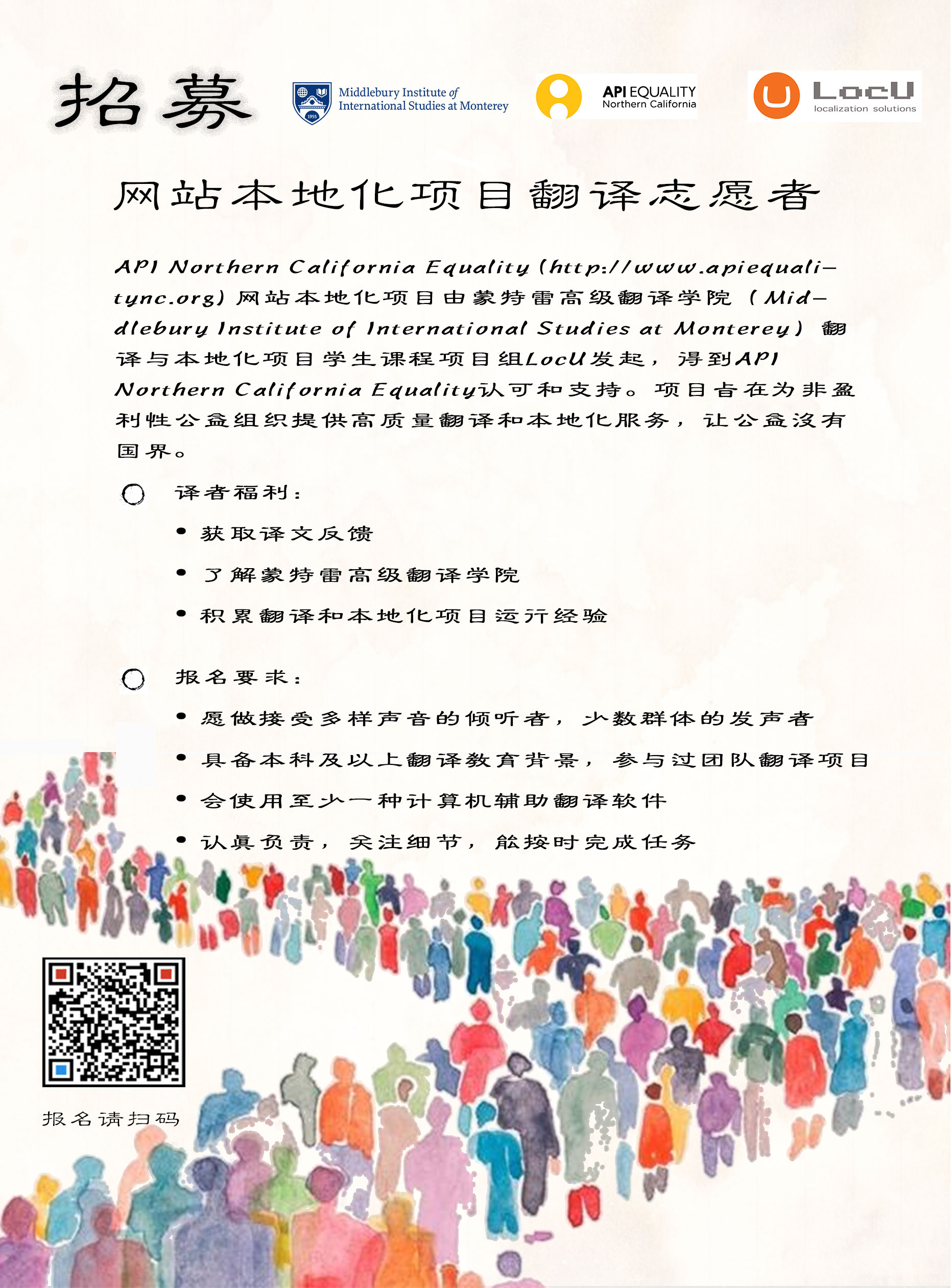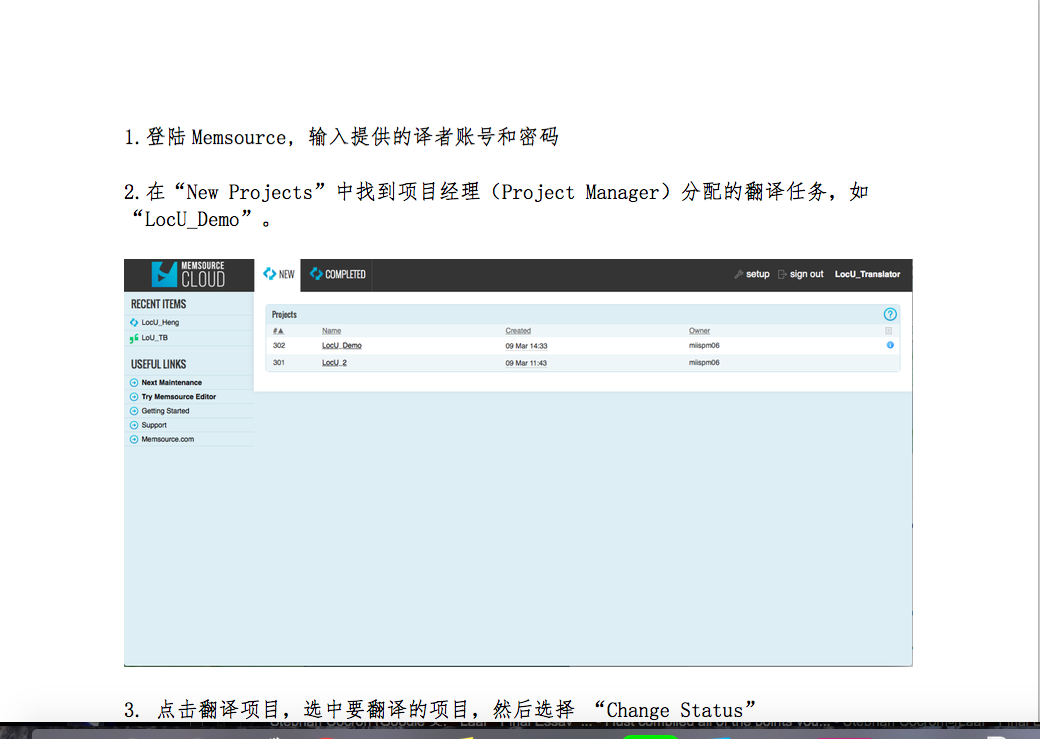Heng Wu
Expertise: Localization Management | Translation |
DTP | QA
Education: M.A. in Translation and Localization
Management, Graduated from Middlebury
Institute of International Studies at Monterey
Project Title: Vendor Manager; Account Manager
Project: Website Localization for API Equality – Northern California (http://www.apiequality.middcreate.net/zh/)
Introduction
API Equality – Northern California is a non-profit organization that supports multiple LGBTQ movements for Asian Pacific Islanders in Northern California.
The team consists of 4 people. YU Yunxi is the project manager. Sijing is the Engineer and XU Li is the TEP coordinator. My name is Heng Wu, the account manager and vendor manager of this project. Although we took different responsibilties, as the project progressed, we put on different hats as needed.
Below is a short video that I made using Abode After Effects to give you an overall look of this project.
https://www.youtube.com/watch?v=nxgysyIUPsc&feature=youtu.be
Account Management
I on-boarded the client in March, 2016. After engaging with the client about this project, I sent a detailed proposal, which specified the workflow, total word count, project timeline, etc. Further, I organized Skype meetings, which were held every other week, between the team members and the client in order to keep the client updated on the progress, answer the client’s questions, among others. Moreover, I submitted weekly reports to the client via email in which I summarized the proceedings of the Skype meetings. I further requested the client to provide me with additional information about the glossaries and the client’s preferred translation tones.
Due to the effective client relationship management, the client was very responsive to my team members and me. Overall, the client thought very highly of our project and provided us with positive feedback.
https://www.youtube.com/watch?v=EjjsqA5fb5o&feature=youtu.be
Vendor Management
Due to the large volume of translation work, we decided to engage in-country translators from the top universities in China. To begin with, we created a poster using Photoshop.
At the end, we successfully engaged 11 translators, all of whom are post-graduate students, specializing in translation skills, from the top 10 universities in China.
Since most of them were first-time users of Memsource, the CAT tool that we chose to use in this project, I decided to create step-by-step instructions both in PDF and video tutorial.
On Memsource, I set up TM, TB, all the translator and editor accounts, and managed to oversee the progress of translation and editing. After about 1 month, we completed the translation and editing phases.
CAT Tool Exploration
In the process of translation and edting, we encountered a problem. When the translators were translating the files, the translations were uploaded to the Cloud translation memory in real-time. However, when it came to the editing phase, the editors had a hard time distinguishing between the approved original translation memory and the new ones from the translators. As a result, we were thinking if it were possible to give editors the orginal translation memory only and have the translators to work collaboratively through Cloud at the same time.
What about giving translators and editors desktop translation memory instead of using Cloud memory? So, there is a question, what are the advantages and disadvantages of desktop and Cloud Memory? Here is what I found:
First of all, Desktop Translation Memory. If the editors are given the desktop orginal memory only, he or she will not be affected by the new memory created by translators. Desktop Memory is not restricted by the Internet, so it can be accessed quickly, regardless of the size of the translation memory.
However, if the Desktop Memory is given to translators and editors, the translation company would take the risk of losing the language assets. And, the translation memory cannot be shared remotely in a group.
Then, what about Cloud Translation Memory? Cloud Translation Memory can be shared remotely and is searchable anytime, anywhere with the Internet. Additionally, translators and editors are not allowed to download the TM and TB, so the security of language assets is guaranteed.
However, at the same time, the Cloud Translation Memory is restricted by the internet access. Additionally, the search results come out very slowly when the memory is either too big or the intenet speed is not fast enough, which will greatly affect work efficiency.
What would be the best solution to the problem that we faced? After some research, the best solution would be working with Desktop and Cloud Memory at the same time. For example, SDL Trados Studio allows desktop translation memory to be encrypted at different levels in order to ensure the security of language assets. At the same time, we can use SDL Groupshare to centralize, share and collaborate on all our translation projects.






